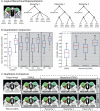Hierarchical performance estimation in the statistical label fusion framework
- PMID: 25033470
- PMCID: PMC4391396
- DOI: 10.1016/j.media.2014.06.005
Hierarchical performance estimation in the statistical label fusion framework
Abstract
Label fusion is a critical step in many image segmentation frameworks (e.g., multi-atlas segmentation) as it provides a mechanism for generalizing a collection of labeled examples into a single estimate of the underlying segmentation. In the multi-label case, typical label fusion algorithms treat all labels equally - fully neglecting the known, yet complex, anatomical relationships exhibited in the data. To address this problem, we propose a generalized statistical fusion framework using hierarchical models of rater performance. Building on the seminal work in statistical fusion, we reformulate the traditional rater performance model from a multi-tiered hierarchical perspective. The proposed approach provides a natural framework for leveraging known anatomical relationships and accurately modeling the types of errors that raters (or atlases) make within a hierarchically consistent formulation. Herein, the primary contributions of this manuscript are: (1) we provide a theoretical advancement to the statistical fusion framework that enables the simultaneous estimation of multiple (hierarchical) confusion matrices for each rater, (2) we highlight the amenability of the proposed hierarchical formulation to many of the state-of-the-art advancements to the statistical fusion framework, and (3) we demonstrate statistically significant improvement on both simulated and empirical data. Specifically, both theoretically and empirically, we show that the proposed hierarchical performance model provides substantial and significant accuracy benefits when applied to two disparate multi-atlas segmentation tasks: (1) 133 label whole-brain anatomy on structural MR, and (2) orbital anatomy on CT.
Keywords: Hierarchical segmentation; Label fusion; Multi-atlas segmentation; Rater performance models; STAPLE.
Copyright © 2014 Elsevier B.V. All rights reserved.
Figures








References
-
- Aljabar P, Heckemann R, Hammers A, Hajnal J, Rueckert D. Multi-atlas based segmentation of brain images: Atlas selection and its effect on accuracy. Neuroimage. 2009;46:726–738. - PubMed
-
- Artaechevarria X, Muñoz-Barrutia A, Ortiz-de-Solorzano C. Combination strategies in multi-atlas image segmentation: Application to brain MR data. IEEE Trans. Med. Imaging. 2009;28:1266–1277. - PubMed
Publication types
MeSH terms
Grants and funding
LinkOut - more resources
Full Text Sources
Other Literature Sources
Medical

